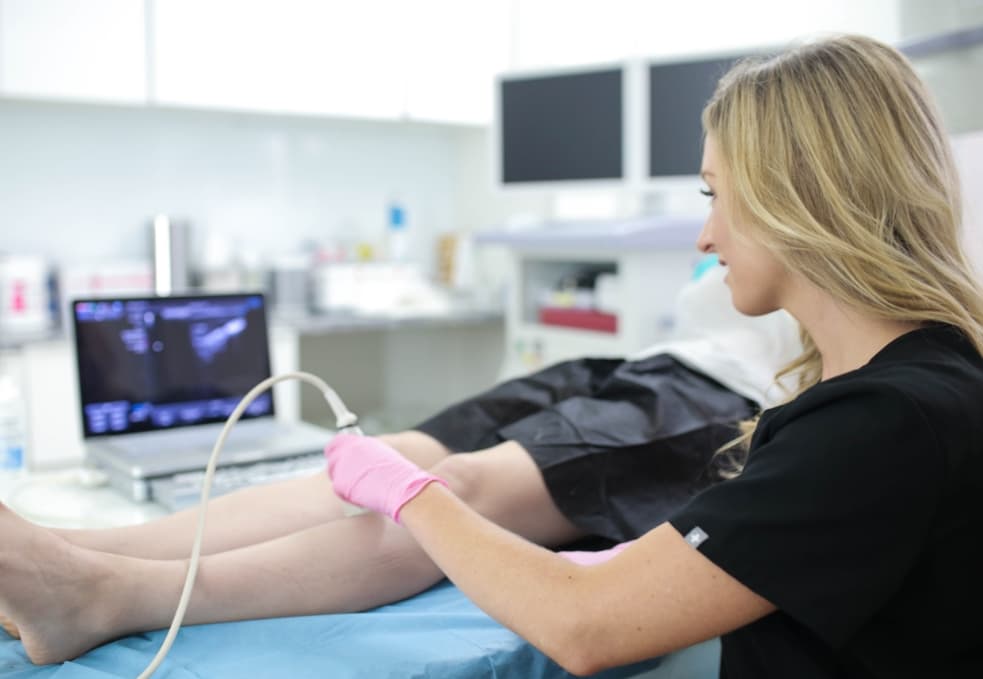How long does it take to recover from vein ablation?
Endovenous ablation is one of the most effective minimally invasive procedures for chronic venous insufficiency. During endovenous (vein) ablation, the vein doctor makes a small incision on the skin’s surface after administering local anesthesia. The incision serves as an entry point for a specialized catheter that’s driven into the diseased saphenous vein under ultrasound guidance. Once the catheter is lodged inside the diseased vein, it generates laser or thermal energy to destroy the diseased vein. The accumulated blood flows into healthier leg veins to restore optimal blood circulation to the heart.
The complete endovenous ablation procedure concludes within an hour. It’s a safe, minimally invasive, outpatient procedure that doesn’t involve any downtime. You can return home immediately after your vein ablation procedure and resume your daily activities. Most people undergo vein ablation during their lunch break and then continue working. But you will have to avoid strenuous workouts, wear compression stockings, and follow some post-treatment aftercare guidelines. Vein ablation causes extremely mild side effects, such as swelling, tenderness, and redness around the treatment area. The full recovery takes 1 to 2 weeks.
Maryland Vein Center is a luxurious medical center specializing in cutting-edge minimally invasive treatments for spider veins, varicose veins, and chronic venous insufficiency. We use the latest and safest techniques to address the root cause of your vein problems, ensuring safe and consistent results. Our considered approach to vein care minimizes the risk of complications. You can find our state-of-the-art vein center in Maryland at 10215 Fernwood Rd, Suite 301, Bethesda, Maryland, just outside of Washington, DC, in Silver Spring. Please schedule an appointment to explore your vein ablation options.

How long does vein ablation pain last?
After endovenous ablation, you can expect mild discomfort and soreness for 1 to 2 weeks. The pain and discomfort are perfectly tolerable, but you can also take over-the-counter pain medications to alleviate discomfort. Your legs might also look bruised around the treatment area, and the incision site might look particularly red. This is a normal part of the recovery process, and it should heal after 2 to 3 weeks.
Some patients also feel like their vein problems are worsening after vein ablation. That’s nothing to worry about. Endovenous ablation destroys the diseased vein and turns it into hardened scar tissue, so it feels hard and looks dark against your skin. You might think your condition is worsening. But the scar tissue is eventually reabsorbed by the body, following which it fades away from the skin’s surface within a few weeks.
What can you not do after vein ablation?
After endovenous ablation, you must avoid placing extreme pressure on your legs. You should avoid strenuous workouts, such as weight lifting, aerobic exercises, bicycling, and swimming for a week or two. But it’s perfectly okay (and even encouraged) to walk regularly. You must also avoid sitting or standing still in one place for long periods of time. If you have a desk job, take short breaks every 30 minutes to walk around your office.
Can I walk after vein ablation?
You can walk immediately after vein ablation. Most patients resume their daily activities immediately after the treatment. While you should avoid running, heavy lifting, and other strenuous workouts, you should walk for at least 30 minutes every day. Walking improves blood circulation and prevents the accumulation of blood in leg veins, so it’s highly encouraged.
How painful is vein ablation?
The vein ablation procedure is a minimally invasive treatment performed under local anesthesia. You will feel no pain or discomfort during the treatment — maybe just a pinch when the anesthetic needle enters your skin. After the vein ablation procedure, you may experience mild discomfort and soreness for a few weeks, but you can take pain medications to alleviate discomfort.
How do you feel after vein ablation?
You may experience mild soreness and discomfort in your legs after vein ablation for the first week or two. But vein ablation will also reduce swelling, leg heaviness, leg pain, and the appearance of varicose veins, so the feeling of relief will outweigh the temporary discomfort.
How long do you wear compression stockings after vein ablation?
You must wear compression stockings after vein ablation to reduce swelling and ensure optimal recovery. Most patients are advised to wear compression stockings for four weeks after vein ablation. You may have to wear compression stockings 24/7 for the first week or two, following which you can reduce the usage. Your vein doctor will discuss how often you need to wear compression stockings.
Can I drive home after vein ablation?
You can resume your daily work and activities after vein ablation, but it’s advised to have someone else drive you home immediately after the procedure. The day after the procedure, you can start driving short distances. Your vein doctor will advise when it’s okay to drive long distances again.
Is vein ablation a good idea?
Vein ablation is certainly a good idea if you have chronic venous insufficiency, the root cause of most vein problems. If you have vein disease, vein ablation is the most effective means of addressing the root cause of spider veins and varicose veins, thus alleviating leg pain and discomfort.
How long does leg ablation take?
The leg vein ablation procedure usually concludes within an hour, following which you can return home and resume your daily activities.





